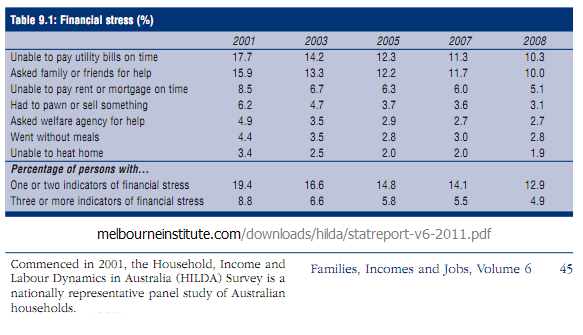The Household, Income and Labour Dynamics in Australia (HILDA) Survey is a nationally representative panel study of Australian households.
The study was commissioned, and is funded by, the Australian Government Department of Families, Housing, Community Services and Indigenous Affairs (FaHCSIA) and is managed by the Melbourne Institute of Applied Economic and Social Research at the University of Melbourne.
Results from this survey include the changes in Financial Stress changes in Australia during the years 2001, 2003, 2005, 2007 and 2008.
This chart from page 45 of the report shows a selection of Financial stresses and how the numbers involved have changed from 2001 to 2008.
It is interesting to see how more people were in financial stress in 2001 than they were in 2008, in EVERY category.
The persistence of financial stress shows how many people from one year were still in financial stress in the following year. Full figures for this are on page 46 of the report, but briefly:
- 54.1% of those in stress in 2001 were still in stress in 2002
- 45.1% of those in stress in 2007 were still in stress in 2008
These figures are seeming to show that most people were better of by 2008 than they were in 2001. Elderly single females however, were the exception to this, showing no change in Financial stress when comparing the 2001 year to 2008.
Mean usual weekly hours of work
Table 14.1: page 68
The Mean usual weekly hours of work in all jobs shown on page 68 of the report showed:
- 42.8 hrs Male 2001
- 42.0 hrs Male 2008
- 31.7 hrs Female 2001
- 31.7 hrs Female 2008
A slight reduction in weekly hours for men, but no change for females.
Perceived financial wellbeing
Table 22.1: on page 107.
The numbers stating that they were either Poor or Very Poor changed between 2001 and 2008 as follows:
- 4.2% in 2001
- 3.5% in 2008
The numbers stating that they were Reasonably comfortable changed between 2001 and 2008 as follows:
- 51.4% in 2001
- 53.1% in 2008
Source: http://melbourneinstitute.com/hilda/statreport.html

